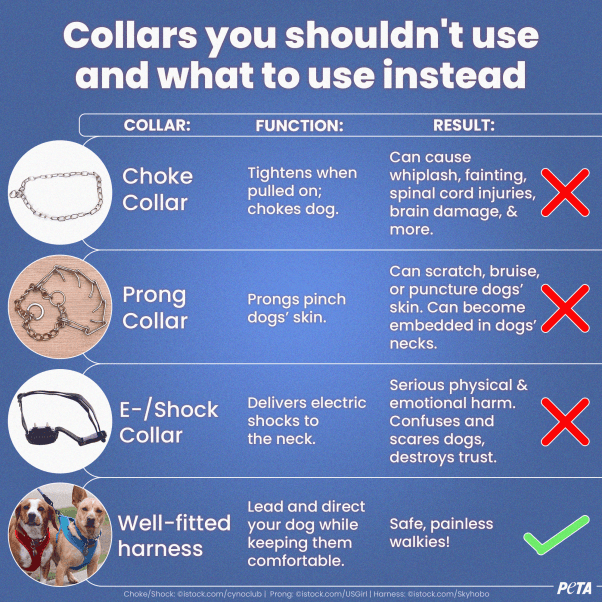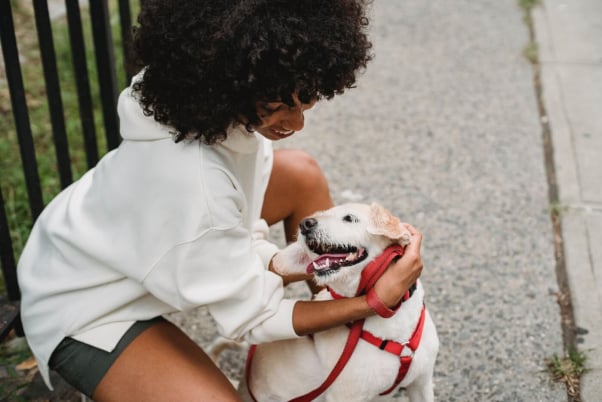Are YOU a Jerk Dog Owner? PETA Sniffs Out 5 ‘Everyday’ Types of Dog Abuse
It should be common sense, but for some reason, many dog guardians think it’s OK to use archaic torture tools (prong collars, anyone?) on their canine companions or to sentence dogs to endless hours inside a tiny crate. The “average” dog abuser could be the person in front of you at the bank, your personal trainer, or the person who scanned your groceries. Or—could it be you?
Dogs experience pain, fear, betrayal, and confusion, just as humans do. Yet much abuse inflicted on dogs is so routine that people don’t think twice about what they’re actually doing to someone who loves, trusts, and depends on them for safety. So PETA is calling those people out. Anyone who subjects their dog to the following types of abuse must stop now—and stop kidding themselves: They’re hurting their “best friend.”
Here are five ways people abuse their dogs without even realizing it:
1. Using shock collars, choke and prong collars, and electric (“invisible”) fences
Shock collars deliver painful jolts to dogs’ necks when they cross invisible boundaries, use their voices, or engage in other perfectly natural behavior. These devices can cause anxiety, displaced aggression, and injuries ranging from burns to cardiac fibrillation. Choke and prong collars punish dogs by inflicting pain when they walk. They can cause serious physical and emotional damage—including spinal cord injuries and paralysis, crushed tracheas and asphyxiation, crushing and/or fracture of the larynx, dislocated neck bones, and bruising of the esophagus. And invisible fences leave dogs completely vulnerable to attacks by roaming dogs and cruel humans, who can freely enter the yard.
Do better: Walk dogs using a comfortable, well-fitting nylon harness or a front-clip harness to gently reduce pulling, if needed. Secure your property with physical fencing that lets pups frolic safely, without risk of escape or electric shock. And spend time with your dogs so that they understand what to do on a walk.
2. Locking dogs in solitary confinement (aka “crating”)
Imagine being stored in a box all day long. Crates deprive dogs of the opportunity to fulfill their basic needs, including stretching, relieving themselves, and enjoying any semblance of freedom to walk about. No one thrives in isolation. Dogs don’t just crave contact with others—as highly social pack animals, they need it. If deprived of social interaction, they become lonely, depressed, and withdrawn and can develop other psychological problems. If a fire or flood occurs while no one else is at home, crated dogs have no escape and can burn to death or drown, trapped inside their cages. Don’t make dogs prisoners in their own homes.
Do better: Take dogs for a long walk in the morning, dog-proof your house, leave out plenty of chew and puzzle toys while you’re away, and come home on your lunch break or hire a trusted dog walker. Or take your dogs to doggie daycare or have them spend the day with a trusted friend or family member who works from home. Then give the dogs playtime and another walk when you get home.
3. Rushing dogs through THEIR walks
You wouldn’t like to be rushed through your coffee-and-morning-news routine—and dogs don’t like being rushed, either! Neighborhood walks are how dogs get the “lay of the land.” Sniffing, looking around, greeting other dogs, and being allowed to take their time are imperative for their mental and physical health. Dragging them along at your pace, staring at your phone, taking them out only to the front lawn for a hurried pee, or chiding them when they pause on a walk is more than unfair—it’s cruel.
Do better: Remember, walks are more than a bathroom break for dogs—they’re an excursion and the highlight of their day! So take them outside often and let them go at their own pace. Pro tip: A tired and fulfilled dog is less likely to chew on a chair when you’re running out for groceries.
4. Swatting, hitting, slapping, kicking, shoving, and other violent bullying
No. No. No. Not ever. If you do any of these to your trusting and loyal canine companion, you are the one who needs to be punished. There’s no such thing as “gently” hitting your dog. Being swatted with a newspaper or shoved off the furniture hurts bodies and feelings. Even if these mean acts don’t leave a visible bruise on your dog, they can cause deep emotional and psychological harm.
Do better: Guide your dogs using positive reinforcement only. If you want a punching bag, go to the gym—don’t subject a dog to your own psychological problems.
5. Yelling at dogs and/or never letting them speak
Punishment-based “training” methods, including yelling at dogs, have serious long-term negative effects on their mental health. One study found that dogs subjected to punitive training methods had higher levels of cortisol, a stress hormone. In other words, screaming at dogs stresses them out and makes them sad and depressed. It’s also rude to shush your canine companion the minute they make a peep. Barking is as natural and necessary for dogs as talking is for humans, and your dog may be telling you something important, like “I’m in pain” or “The house is on fire.”
Do better: Always speak kindly to your dogs, take time to understand what they’re saying, and make every effort to meet their needs. If you aren’t willing to let a dog speak (bark) now and then, please don’t adopt one.
*****
If you’re subjecting your dog to any of these types of abuse, please stop now and make amends to your canine companion—and if a friend or family member is guilty of any of this abuse, don’t hesitate to speak up and encourage them to shape up for their pup as well.






